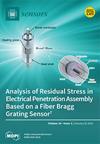Three-Dimensional Human Posture Recognition by Extremity Angle Estimation with Minimal IMU Sensor
IF 3.4
3区 综合性期刊
Q2 CHEMISTRY, ANALYTICAL
引用次数: 0
Abstract
Recently, posture recognition technology has advanced rapidly. Herein, we present a novel posture angle calculation system utilizing a single inertial measurement unit and a spatial geometric equation to accurately identify the three-dimensional (3D) motion angles and postures of both the upper and lower limbs of the human body. This wearable system facilitates continuous monitoring of body movements without the spatial limitations or occlusion issues associated with camera-based methods. This posture-recognition system has many benefits. Providing precise posture change information helps users assess the accuracy of their movements, prevent sports injuries, and enhance sports performance. This system employs a single inertial sensor, coupled with a filtering mechanism, to calculate the sensor’s trajectory and coordinates in 3D space. Subsequently, the spatial geometry equation devised herein accurately computed the joint angles for changing body postures. To validate its effectiveness, the joint angles estimated from the proposed system were compared with those from dual inertial sensors and image recognition technology. The joint angle discrepancies for this system were within 10° and 5° when compared with dual inertial sensors and image recognition technology, respectively. Such reliability and accuracy of the proposed angle estimation system make it a valuable reference for assessing joint angles.用最小的 IMU 传感器通过肢体角度估计识别三维人体姿态
近来,姿势识别技术发展迅速。在此,我们介绍一种新型姿势角度计算系统,该系统利用单个惯性测量单元和空间几何方程,准确识别人体上下肢的三维运动角度和姿势。这种可穿戴系统便于对身体运动进行连续监测,而不会出现基于摄像头的方法所带来的空间限制或遮挡问题。这种姿势识别系统有很多好处。提供精确的姿势变化信息有助于用户评估其动作的准确性,预防运动损伤,提高运动表现。该系统采用单个惯性传感器和过滤机制来计算传感器在三维空间中的轨迹和坐标。随后,本系统设计的空间几何方程精确计算了身体姿势变化时的关节角度。为了验证其有效性,我们将拟议系统估算出的关节角度与双惯性传感器和图像识别技术估算出的关节角度进行了比较。与双惯性传感器和图像识别技术相比,该系统的关节角度差异分别在 10° 和 5° 以内。拟议角度估算系统的可靠性和准确性使其成为评估关节角度的重要参考。
本文章由计算机程序翻译,如有差异,请以英文原文为准。
求助全文
约1分钟内获得全文
求助全文
来源期刊

Sensors
工程技术-电化学
CiteScore
7.30
自引率
12.80%
发文量
8430
审稿时长
1.7 months
期刊介绍:
Sensors (ISSN 1424-8220) provides an advanced forum for the science and technology of sensors and biosensors. It publishes reviews (including comprehensive reviews on the complete sensors products), regular research papers and short notes. Our aim is to encourage scientists to publish their experimental and theoretical results in as much detail as possible. There is no restriction on the length of the papers. The full experimental details must be provided so that the results can be reproduced.
 求助内容:
求助内容: 应助结果提醒方式:
应助结果提醒方式:


